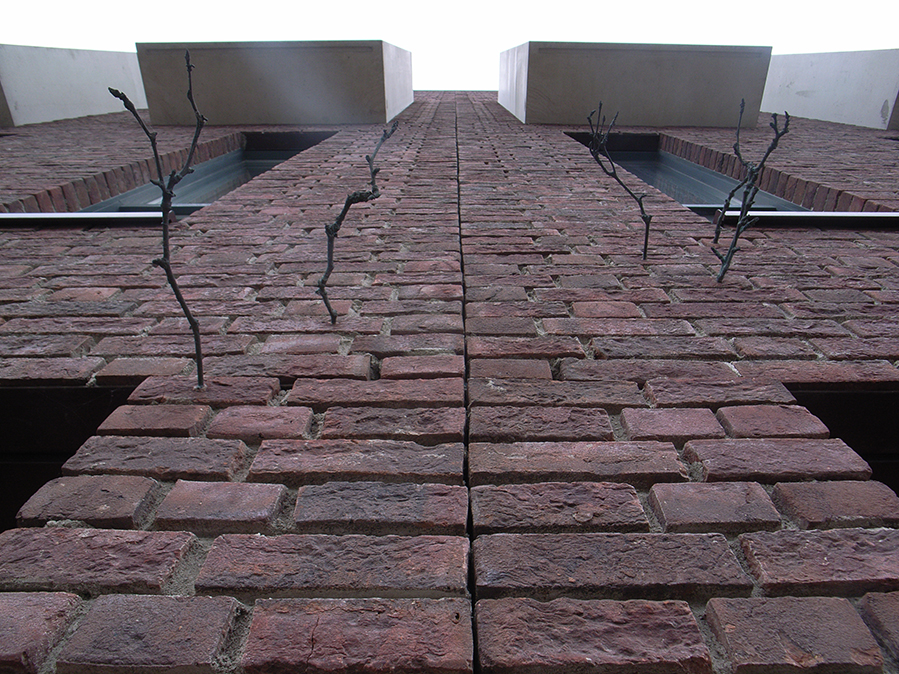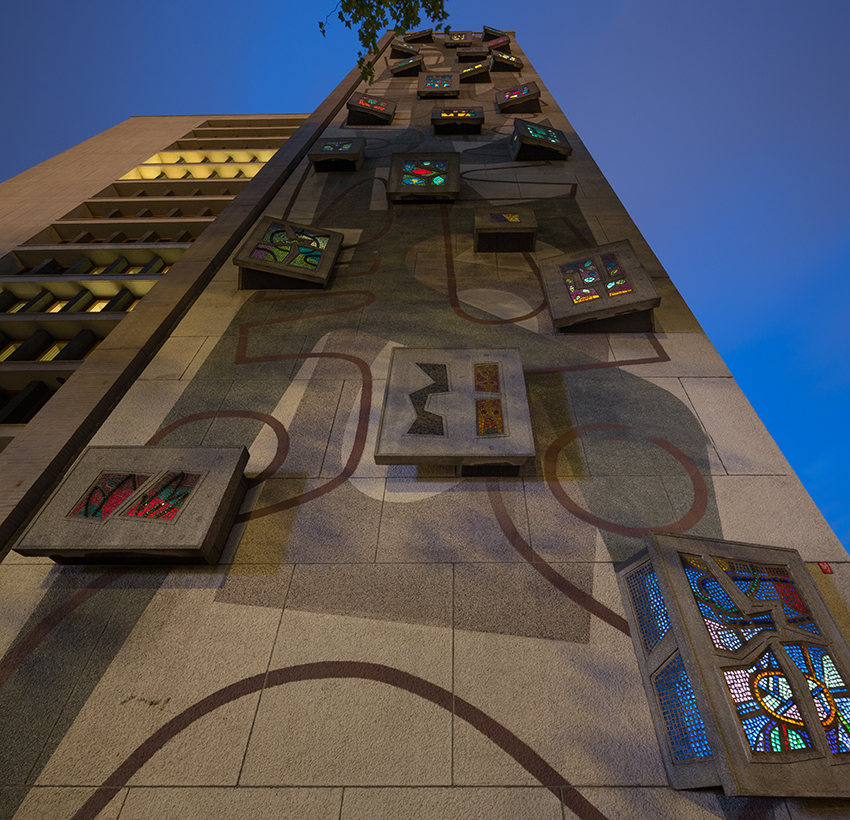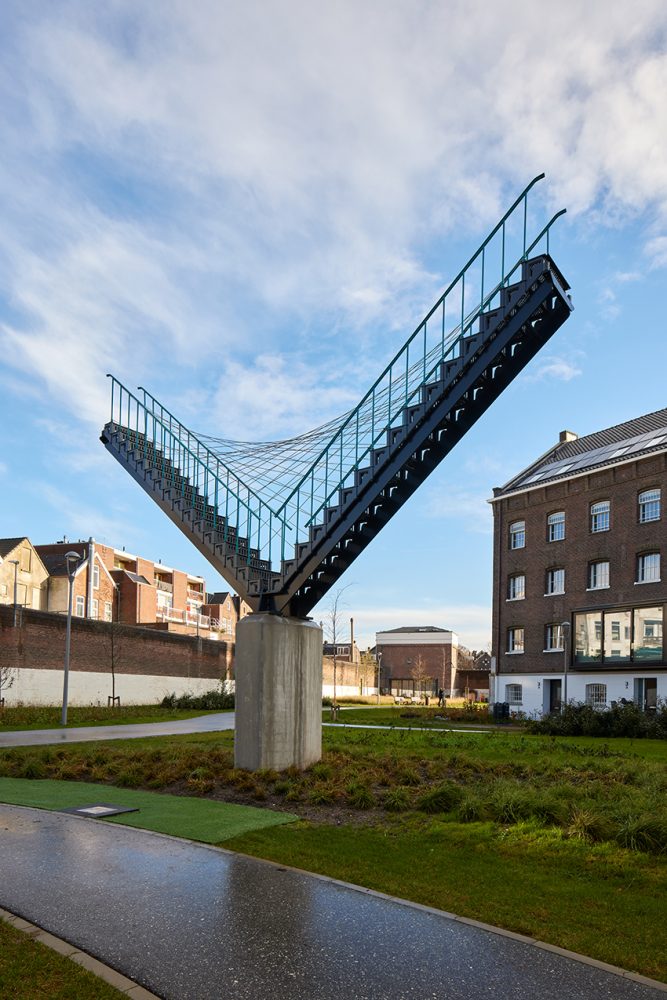Art in public space: from participation to city promotion
After twenty years of working on art in Rotterdam's public space, Siebe Thissen said goodbye at the end of 2021. BK-informatie asked him to look back at the past two decades. What stands out to him and what has changed?

From the university to CBK Rotterdam
Siebe Thissen is often referred to as a philosopher and historian given his studies at Erasmus University Rotterdam. When he started working at CBK Rotterdam in 2000, he had yet to obtain his doctorate. In addition to his doctorate, he worked with the Center for Art and Philosophy, founded by Rotterdam philosophers Awee Prins and Henk Oosterling. Their goal was to bring philosophy from the backroom to the city. The themes they broached did not lie: violence, physicality, pornography, serial killers. Thissen participated on behalf of the Center for Art and Philosophy in projects with VJs, hip-hop, graffiti and much took place during the nightlife. He got to know the then director of CBK Rotterdam, Hans Walgenbach, and was asked by him to come and work there temporarily. Rotterdam as a city was in a state of flux, both physically and mentally, and that called for a more dynamic approach to the arts. Thissen had already shown that such a way of working suited him well.
Art as a necessary part of the urban dynamic, that was what he had in mind when he took office, together with coalition partners such as housing corporations, community centers, welfare organizations, residents' associations, etc. Artists and works of art in particular are able to relate explicitly to a place in the city or to the users of a place. "Art in public space makes a city readable," says Thissen. Works of art tell a story about the city and about the users of that city."
2000 - 2010 philosopher and activist
Thissen explains that in the early '00s Rotterdam not only possessed a fine collection of sculptures but was also the home of a generation of artists who took their audience, their fellow Rotterdammers, very seriously. Many artists worked in neighborhoods, districts and streets from a committed social autonomy and no longer merely in the confines of a studio. Think of artists like Jeanne van Heeswijk, Hieke Pars, Kamiel Verschuren, Paul Cox, Rolf Engelen and Jan Konings. This generation of artists succeeded in "involving the city and new audiences in art in a noncommittal yet inescapable way," Thissen explains.

Rolf Engelen, From Vlinderbuurt to Takkenwijk, 2001. Photo: BKOR archive
Area development offered plenty of opportunities for these artists, as neighborhoods such as Noordereiland, Katendrecht, Oud-Charlois, Crooswijk and Nesselande were (re)developed on a large scale. As a result, many dozens of Rotterdam artists were working in these neighborhoods and districts between 2000 and 2010 during the revitalization process. The public-private partners (project developers, housing corporations, etc.) who were involved in the (re)developments were happy to make use of the artists' interventions. CBK Rotterdam, as city broker, provided many commissions to local artists. Sometimes an artist's contribution resulted in a temporary or permanent work, sometimes it was one or more interventions that left nothing tangible behind but experiences and memories.
This generation of artists succeeded in engaging the city and new audiences in a noncommittal yet inescapable way with art
CBK Rotterdam praised this socially engaged approach, says Thissen, in which the artist himself was responsible for the quality of the artworks. In addition to his role as commissioner, he also took seriously the role of mediator, mediator of the dynamics between the city and the artists. He worked proactively on a network of partners that benefited the artists and vice versa. So he talked a lot with residents, with organizations and tried to convince them of the necessity of visual arts for the city. These were fruitful years for small and large commissions. The artists were appreciated in the city and residents felt heard and became involved. The artists made the city not only legible, but also livable.
As a philosopher, Thissen wrote books and articles in this period about the role of art in the city and in which area-oriented work was scrutinized. For years public art intertwined with the extensive area development in Rotterdam. From his position at CBK Rotterdam, he wanted to learn how the dialogue between artists and area developers, between neighborhoods and art institutions could be strengthened. "What do we expect from each other? How do we propel each other towards more quality, support and sustainability?" It offered food for thought. These were questions that arose from the conviction that the deployment of artists in area developments would be good for art and for the city. In a sense, these were golden years. Many artists were fully employed, therefore had an income and were widely appreciated in Rotterdam society. Until the financial crisis of 2008.
2010-2021 historian and activist
That crisis affected many sectors including cultural ones. The then Minister Blok (Housing and Spatial Planning) intervened hard with housing corporations. He was of the opinion that liveability was not a core task of the corporations but that they should focus on managing (social) real estate. Financial swindles (Vestia) and failed giga projects (Woonbron) had confirmed this view. But this brought the collaboration between CBK Rotterdam and housing corporations and area developers to a halt. The national government imposed on the housing corporations that they were no longer allowed to release funds for the quality of life. Commissions to artists, often paid for by housing corporations from quality of life budgets, were withdrawn, shortened or stopped after the design phase.
With great patience and dedication, the collection was pictured and owners were found
Parallel to this development, there were hassles with the collection of artworks in public spaces. An artwork was set on fire, another was pulled over and yet another was lost. No information was available about some sculptures, others were not maintained and languished. The Municipality of Rotterdam was responsible for the maintenance of approximately 200 works of art, while the outdoor collection consisted of many more. The historian in Thissen emerged. He wrote an alarm letter to the alderman to draw her attention to this omission. His letter did not fall on deaf ears; he received permission to survey and investigate the entire collection. The owner of many works of art was unknown, the so-called orphan images. With great patience and dedication, Thissen and his colleagues surveyed the collection and found owners. Then it was time to appreciate the works of art: how good are they? What place do they occupy in the collection? Do they have an emotional value, that is, is the work embraced by the neighborhood? And what is the condition of the work?

Louis van Roode, untitled, 1959. Photo: Ossip van Duivenbode (BKOR archive collection)
Assigning artworks a status suddenly allowed many more works to be maintained. In this way top works maintained every year, category A structures are maintained every two to three years, and lower status structures receive attention only when something is really wrong.
The municipality of Rotterdam was responsible for the maintenance of approximately 200 works of art, while the outdoor collection consisted of many more works.
It was thanks to this research that the breadth of the collection of artworks in the public space came into clear focus - after all, in addition to sculptures and murals, the city also has play sculptures, monuments, wall reliefs and square furnishings. CBK Rotterdam saw that there were gaps and that many sculptures were in poor condition. More attention had to be paid to the history of the collection. A website was created on which all the works of art in the collection could be found, with the available information. A gigantic job. The website makes the breadth and scope of the collection of artworks clear. It is an impressive amount and all the artworks matter in their individuality. Rutger Pontzen, art critic at The People's Newspaper, put it this way in 2011: "I would venture the proposition that there is no city in the Netherlands that pays as much attention to art in public space as Rotterdam."
Of course, new works of art were also added to the collection. In Rotterdam, two traditions played a role in this, both started in 1960. The municipality looked with admiration at the business community, at how good the art was that they realized - Zadkine at the Leuvehaven, Henry Moore at the construction center, Naum Gabo at the Bijenkorf.
The alderman at the time wanted a committee with experts: that became the City Beautification Committee. Three leading figures from Rotterdam were given an annual budget to buy art. To do so, they travelled the world from Paris to New York. They were able to buy works by Alexander Calder, Rodin, Picasso and others. They had the knowledge and the network, and could negotiate the price. Sculpture International Rotterdam eventually evolved from this; sculptures of exceptional, international quality are placed there uninvited.
Participation is part of the process, but the artist must be free to make a work
In addition - also in 1960 - the percentage regulation came into force. In the construction of municipal buildings, from now on, approximately 1% of the construction sum could be spent on visual art. In contrast to the philosophy of the Urban Embellishment Committee, a more participative approach could be initiated here, with the participation of architects and users of the buildings. The percentage scheme was also good for employment of local artists.

Madeleine Berkhemer, Parabola Blues, 2021. Photo: Aad Hoogendoorn (BKOR archive collection)
From this tradition came a Rotterdam, participatory direction. Residents are allowed to think about what kind of artwork they want, giving CBK Rotterdam a good idea of what is going on in the neighborhood. CBK Rotterdam then nominates artists. Participation is part of the process, but the artist must be free to create a work. It is a good thing that residents are closely involved in the thinking of artists about a particular place. Thissen considers it important and unique that international-artistic and social-local traditions can still exist side by side in Rotterdam.
In recent years
The complexity of public space has increased in recent years, Thissen observes. According to him, there is a new dynamic in place in which fear and propaganda seem to dominate. Officials and urban developers are terrified of offending this or that group. And urban promotion turns works of art into meaningless advertising objects that have to praise hip Rotterdam. The autonomy of art is under pressure. Look at street art. Most paintings say little about the city, says Thissen. They are cheerful stickers, meant to make selfies, pump the images around and promote the city. Rotterdam is probably the only city where murals say nothing about the neighborhoods in which they appear. That's a shame, because a mural is precisely the medium with which you can say something about your neighborhood. That's why the murals of Paris or Berlin are so good.
The complexity of public space has increased in recent years (...) The autonomy of art is under pressure
To NRC he told in 2020In the Tweebosbuurt neighbourhood, for example, there are lots of cheerful paintings, while the residents there are forced to move. That's what street art should be about. Art is also about commenting on the environment. It doesn't all have to be Instagrammable, and fun, and suitable for selfies." In the same newspaper, columnist Lotfi El Hamidi wondered, "Where is the Rotterdam Banksy?" According to Thissen, such a Banksy has no chance here. He sees the emergence of a frictionless public space in which no relevant questions are asked anymore, but artworks are mainly a means to contribute to the objectives of administrators, city makers and project developers.
This development is also visible in the municipality of Rotterdam. Applying for permits for works of art has become a thankless, time-consuming exercise, with officials increasingly reporting "that they didn't get any hours," leaving CBK Rotterdam on its own and having to endlessly tug at officials and services. "Moreover, officials also interfere with the content of an artwork," says Thissen. "They question the critical message of the work or are afraid of "what people think of it". But they're not about that at all," he says. "That's what art is for." A work of art increasingly seems to be perceived as an intrusion into public space. In such a climate it is a blessing that there are once again philanthropists who are prepared to help think about the city's collection.
A frictionless public space in which relevant questions are no longer asked, but artworks are primarily a means of contributing to the goals of administrators, city makers and project developers
"We are constantly called upon to be especially proud of Rotterdam," sighs Thissen. Because 'in Rotterdam it happens'". And he continues: "You don't put Make It Happen on a work of art to show that it happens in Rotterdam. Your art has to be so good and so exciting that others say, 'it happens in Rotterdam'." A revolution is needed in public art, Thissen thinks. What is art itself still capable of and willing to do? Does art want to be merely a vehicle for propaganda? Does art allow itself to be paralyzed by the fear of potentially hurting users of public space? "We live in such an exciting time," Thissen believes. A time in which freedoms are under pressure, the autonomy of art on the street is being gnawed at, and urban promotion has acquired dubious traits."
Want to know more?
- Henk Oosterling and Siebe Thissen (ed.), Metropolitan Reflections. On art and public space (Rotterdam: Erasmus University Rotterdam/CBK Rotterdam, 2002).
- Siebe Thissen and Gepke Bouma (ed.), The great Rotterdam bridge book (Zaltbommel: Aprillis, 2005).
- Siebe Thissen, Beautiful from afar. Murals in Rotterdam (Rotterdam: Trichis Publishing, 2007).
- Marjolijn van der Meijden and Siebe Thissen (ed.), On South. The art of Rotterdam South (Rotterdam: NAi Publishers, 2009).
- Siebe Thissen (ed.), Our city! Action programme Cultural Reach 2004-2008 (Rotterdam: Trichis Publishing, 2009).
- Marjolijn van der Meijden and Siebe Thissen (ed.), Which Work Where? Art and area development in Rotterdam (Rotterdam: CBK Rotterdam, 2010).
- Siebe Thissen, City beautification in Rotterdam since 1940 (Rotterdam: Japsam Books 2016).
- Siebe Thissen, Loeki Metz and the Jewish Monument in Rotterdam (Rotterdam: CBK Rotterdam, 2018).
For an overview of the art collection in Rotterdam: bkor.com


